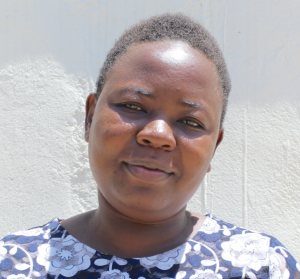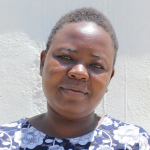May, 2021: Ucheka Spring Project Complete!
Mayuge Community now has access to clean water! We transformed Ucheka Spring into a flowing source of water, thanks to your donation. Our team protected the spring and trained the community on improved sanitation and hygiene practices, including COVID-19 prevention.

Women give a wave of thanks at the protected spring.
"Initially, I used to fear using water from this spring because it was open to all sources of contamination. As we speak, the spring is now protected, hence no more stress when drawing water. I will have plenty of time to carry out my other duties as a mother. I would wake up very early in the morning to avoid overcrowding at the spring, but now, very little time is spent at the spring," said Christine Namanda, a farmer in the community.

Children were just as excited as the adults about the new water point.
"Personally, I have been affected whenever I took water from this spring without it being boiled. My parents have spent a lot of money on medication to ensure I am well. Before spring protection, a lot of time was wasted. I would wait for more than thirty minutes for the water to clear up. Now I will use that time to do my school work, and I am sure there will be a great improvement in my academic performance," said the teenager and secondary school student Rose.

Rose poses on the steps of the spring.
Preparing for Spring Protection
Community members worked together to source and carried all locally available construction materials to the spring. These included bricks, sand, stones, and fencing poles. Some people also chiseled away at large stones to break them down into the gravel. Because people have to carry most items by hand, the materials collection process can take anywhere from a few weeks to months.

Community members deliver materials to the spring using a cart pulled by cattle.
When everything was prepared, we sent a lorry to the community to deliver the rest of the construction materials, including the cement, plastic tarps, and hardware. Then, our artisan and field officers deployed to the spring to begin work. Individual households provided meals throughout each day to sustain the work team.

All ages helped deliver materials to the spring.
From Open Source to Protected Spring: A Step-by-Step Process
At last, it was time to dig in at the spring! Women and men lent their strength to the artisan each day to help with the manual labor. First, we cleared and excavated the spring area. We dug a drainage channel below the spring and several surface runoff diversion channels above and around the spring. These help to divert environmental contaminants carried by the rains away from the spring.

Excavation
To ensure community members could still fetch water throughout the construction process, we also dug temporary diversion channels from the spring’s eye around the construction site. This allowed water to flow without severely disrupting community members’ water needs or the construction work.

Laying the foundation
Excavation created space for setting the spring’s foundation made of thick plastic tarp, wire mesh, concrete, and waterproof cement. After setting the base, we started brickwork to build the headwall, wing walls, and stairs.

Bricklaying
Next, we began one of the most crucial spring protection steps to ensure a fully functional water point: setting the discharge pipe. The discharge pipe has to be low enough in the headwall so that the water level inside never rises above the spring’s eye, yet high enough to leave eighteen to twenty inches between the pipe and the spring floor. This allows room for the average jerrycan (a 20-liter container) to sit beneath the pipe without making contact.

Setting the pipe
If the discharge pipe were placed too high above the spring’s eye, too much backpressure could force the flow to emerge elsewhere. Too low, and community members would not be able to access the water easily. We embedded the pipe using clay (or mortar when the clay is in short supply) and placed it slightly incline to ensure water flows in the right direction.

Stairs construction
In coordination with brickwork, we pitched medium to large stones on both sides of the spring’s drainage channel. We then cemented and plastered each stone group into place, forming the rub walls. This helps discourage people and animals from standing on that area, which could cause soil erosion and thus a clogged drainage area.

Rub wall construction
We turned to cementing and plastering both sides of the headwall and wing walls with brickwork and stone pitching completed. These finishing layers reinforce the brickwork and prevent water in the reservoir from seeping through the walls. In turn, enough pressure builds in the reservoir box to push water out through the discharge pipe.

Plastering
As the headwall and wing walls were curing, we cemented and plastered the stairs and installed four tiles beneath the discharge pipe. The tiles protect the concrete from the falling water’s erosive force while beautifying the spring and facilitating easy cleaning of the spring floor.

Setting the tiles
We transitioned to the final stages of construction with the tiles in place - backfilling the reservoir box. First, we cleared the collection box of any debris that may have fallen in since its construction, such as dead leaves or other items. Then we redirected the temporary diversion channels back into the reservoir box, channeling water into this area for the first time. We closed off all of the other exits to start forcing the water through the discharge pipe only.

Backfilling
With much help from the community, we filled up the reservoir area with the clean and large stones they gathered, arranging them in layers like a well-fitting puzzle. We covered the stones with a thick plastic tarp to minimize potential contamination sources from aboveground, followed by a layer of soil. We piled enough soil on top to create a slight mound to compensate for the backfill’s future settlement.

Erecting the fence
Community members transplanted grass onto the backfilled soil to help prevent erosion. Finally, the collection area was fenced to discourage any person or animal from walking on it since compaction can lead to disturbances in the backfill layers and potentially compromise water quality.

Men shake hands over the good work done at the protected spring.
The entire construction process took about two weeks of work and patience to allow the cement and plaster to finish curing. As soon as it was ready, people got the okay from our field officers to fetch water. To mark the occasion, community members sang songs of praise to God for answering their prayers. The officer in charge of the station, Betty Muhongo, joined them to celebrate and later handed over the project to the Water User Committee Chair.

Training on Health, Hygiene, COVID-19, and More
Due to the ongoing challenges and restrictions amidst the pandemic, we worked with local leaders and the national Ministry of Health to gain approval for a small group training about health, hygiene, and COVID-19 prevention.
Together with the community, we found their preferred date for training while considering other community calendar events, such as the agricultural season and social events. We requested a representative group of community members to attend training to relay the information learned to the rest of their family and friends.
When the day arrived, facilitator, Betty Mungongo, deployed to the site to lead the event. 22 people attended the training, including community-based leaders. More people wanted to attend, but due to local COVID-19 restrictions, we had to turn people away to keep the group size down. As a coincidence, all attendees ended up being women, which was not our goal, but even the additional community members who wanted to come were women as well. We held the training adjacent to the spring, where the trees provided at least some shade for the training.

Spreading out to ensure physical distancing.
Perhaps the most crucial topic of the day was our session on COVID-19 prevention and control. Due to the rampant spread of misinformation about COVID-19, we dedicated time to a question and answer session to help debunk rumors about the virus and provide extra information where needed.

Building a leaky tin handwashing station.
We covered several other topics, including community participation in the project; leadership and governance; personal and environmental hygiene; water handling and treatment; operation and maintenance of the spring; dental hygiene; the ten steps of handwashing, and how to make and use a tippy tap and leaky tin. We held an election for the newly formed water user committee leaders during the leadership and governance session.

Handwashing demonstration
We also brainstormed income-generating activities that can be used to start a community savings account for any future minor repairs to the spring and a cooperative lending group to enable members to develop small businesses.
The session on safe water handling was one of the most memorable topics. Betty advised the participants to ensure that the surrounding environment where they store their water is always clean and free from any contaminants harmful to human health. The majority of the participants who reside near the spring discussed using smaller containers to store their drinking water since they can refill them more easily. It would help to empty their containers in fewer days to ensure the water does not get old. Finally, Betty urged the participants to train their little children to properly get water from their storage containers to insert unclean hands into the water properly.

The elected Water User Committee leaders pose with Field Officer and Trainer Betty Muhongo (right) following the election at training.
"I have been able to learn more on sanitation matters. I was not aware that drinking water should not stay more than three days in the storage container. I used to fill my water container whenever I noticed that the level of water had reduced," said Jane Nekesa, a farmer, and the elected Water User Committee Secretary.
"Before this training, I was not sure if Coronavirus was real. I would walk with my mask in the pocket to avoid paying a fine to the police. After the training, I have vowed not to fear the police but to be in charge of my life and make sure I adhere to the rules and regulations put in place by the Ministry of Health since it's for my own good," said Felister Milava, also a farmer.

Using as much shade as possible at training
"The importance of using soap and flowing water was the most helpful part of the COVID-19 sensitization training. Initially, I would wash my hands on several occasions but without soap. I realized this when our facilitator demonstrated the ten steps of handwashing," Felister continued.
"Since I have learned what should be done to stop the spread of COVID-19, I will keep on spreading the gospel on how to prevent COVID-19 until everybody is used to the rules and regulations. I will advise my community members not to have meetings in crowded places where they cannot observe the social distance."

When an issue arises concerning the water project, the water user committee is equipped with the necessary skills to rectify the problem and ensure the water point works appropriately. However, if the issue is beyond their capabilities, they can contact our field officers to assist them. Also, we will continue to offer them unmatchable support as a part of our ongoing monitoring and maintenance program.
Thank you for making all of this possible!


 Protected Spring
Protected Spring
 Rehabilitation Project
Rehabilitation Project












































